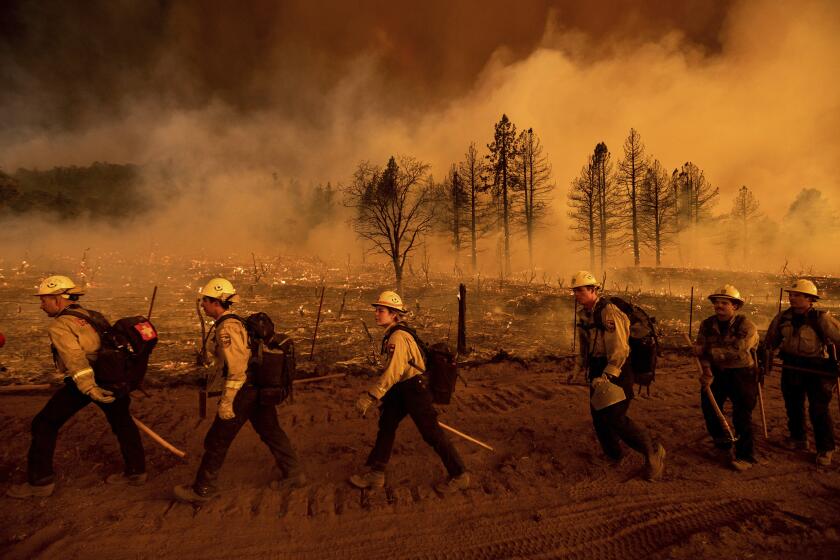Edison knew before Eaton fire that cutting power risked igniting blaze, records show

- Share via
- Southern California Edison was warned in 2022 that an emergency power shutdown risked overloading transmission lines, increasing the risk of a wildfire, according to public records reviewed by The Times.
- Fixes that some experts said could have mitigated the risk were repeatedly delayed, the records show, with scheduled work never completed by the utility company.
- Edison has acknowledged that its equipment may have played a role in starting the Eaton fire, but the exact cause remains under investigation.
On Jan. 7, as fierce winds whipped across the foothills of the San Gabriel Mountains, residents frantically called Southern California Edison, imploring the utility to turn off power around Altadena to keep electrical equipment from sparking a wildfire.
Minutes after 6 p.m., witnesses spotted a fire under an Edison transmission tower in Eaton Canyon. Since then, there has been intense scrutiny from both investigators and experts about whether that tower ignited a fire that destroyed more than 9,000 structures and killed 17 people.
While the exact cause remains under investigation, Edison has acknowledged that evidence suggests its equipment may have played a role. The company previously revealed that its lines over Eaton Canyon saw a momentary increase of electrical current about the same time as the fire began.
What hasn’t yet been fully explained is why the utility delayed shutting off power to much of the area — and whether it could have done more to prevent the catastrophe.
But public records uncovered by The Times indicate the company had been warned less than three years ago about the risk that a power shutdown would overload other transmission lines, potentially causing dangerous overheating and sparks. Fixes that some experts said could have mitigated the risk were repeatedly delayed, the records show, with scheduled work never completed.
Kathleen Dunleavy, an Edison spokeswoman, cautioned against jumping to conclusions about what may have started the blaze.
“We are exploring all possibilities, including the potential involvement of our equipment,” she said in an interview. “We don’t know what caused the Eaton fire.”

The records reviewed by The Times include a series of “wildfire study scenarios” detailed in a March 2022 report prepared by the California Independent System Operator, or CAISO, which oversees electricity flow and transmission planning in the state.
The report showed that preemptively cutting power to a handful of key transmission lines — including some running through Eaton Canyon that fire victims’ attorneys and investigators have zeroed in on — could cause a “Direct Load Impact” of 900 to 1,000 megawatts. That magnitude of surge could cause transmission lines that remained energized to heat up, sag, arc and potentially start a fire, experts said.
Earlier this month, attorneys suing Edison on behalf of fire victims unveiled a new theory that a long-idle tower in the canyon somehow became re-energized that evening, possibly starting the fire.
Edison has said it preemptively cut power to a limited number of lower-capacity distribution lines — the sort typically carried by wooden poles to individual homes and businesses — in areas closest to Eaton Canyon. But it did not de-energize the larger transmission lines that carry electricity through the canyon on massive metal towers until well after the Eaton fire broke out.
Robert McCullough, a veteran energy analyst who has studied decades of wildfires caused by electrical companies, said that in the 2022 study Edison was warned that “there might be some bad ramifications” of such a power shutoff, including “a surge along these major transmission lines.”
Surges can lead to overloading and “catastrophic failure” of power lines, McCullough added.
After an epic dry streak, the first real rain of winter fell in Southern California, bringing elevated risk of floods and landslides to areas recently burned by wildfires.
“The [California Independent System Operator] three years ago was doing studies of issues here and indicated there were good reasons not to de-energize the line,” he said. “And there was in fact a proposed solution that was not completed yet.”
Cody Warner, an energy scholar at the Energy Institute at Haas School of Business at UC Berkeley, said the 2022 study found that the power cuts “would result in loss of load and overloading scenarios, thermal concerns” for nearby transmission infrastructure.
Eaton and Palisades fires
The devastating fires killed at least 28 people, destroying and damaging more than 18,000 buildings valued at more than $275 billion and leaving a burn zone 2½ times the size of Manhattan.
Although the company had been made aware of the risks of cutting power, Warner said, it had to make a difficult decision in the face of treacherous weather conditions. Leaving the lines active also would have been hazardous due to blowing tree branches and other debris.
“We can look after the fact and see that the consequences of potentially not de-energizing the transmission lines are enormous,” he said. “It just shows that the margin of error is so small in these extreme weather events.”
Dunleavy, the Edison spokeswoman, said studies such as the one published in 2022, “didn’t impact SCE’s operational decisions on de-energizations” on Jan. 7.
“They’re looking at transmission planning for hypotheticals,” she said. “That is very different from real operational studies that are used for real-time decision-making.”
Jayme Ackemann, a spokeswoman for the California Independent System Operator, said the purpose of its 2022 study was to assess “if additional transmission system additions would be beneficial” if utilities, including Edison, “needed to preemptively remove” transmission lines from service due to wildfire risk.
The reports “were not designed to inform when public safety power shutoffs (PSPS) should be initiated, and the studies were not used for that purpose,” Ackemann said.
After raising the specter of a major surge from a partial power shutdown, the 2022 study outlined “potential wildfire mitigation solutions” for a crucial segment of transmission line.
By “reconductoring” the line and making improvements to “Substation terminal equipment,” the $17.3-million project would have had “a significant impact on reducing the risk of [Public Safety Power Shutoff] or wildfire event impact.”
The California Independent Service Operator approved the planned work about three years ago, records show. But a document published in July 2024 said the upgrade wasn’t slated to come online until June of this year.
The scheduled work was a “super-important” mitigation measure that could have enabled a power shutdown during the windstorm without the overload risk, Warner said.
“What they found,” he said, “was if they did the reconductoring project, they could de-energize the lines in Eaton Canyon” without triggering a potentially dangerous power surge.
Ackemann, of the California Independent System Operator, said “the project was recognized as having potential benefit ... under a different wildfire study scenario.”
Dunleavy said the reconductoring work has been pushed back due to “material delays,” along with “outage coordination challenges” and the “complexity around transmission and planning transmission through metro areas.”
She said the company now expects the work to be completed in May.
The project, Dunleavy said, “doesn’t have anything to do with” the company’s decisions about whether to cut power on Jan. 7.
As Edison officials have emphasized in recent weeks, she said, wind speeds before the Eaton fire started did not meet the threshold to cut off power to area transmission lines.
“We have protocols that we use for when we de-energize. Those protocols are overseen by the [California Public Utilities Commission],” Dunleavy said. “And they have to do with wind speeds, with the variety of other factors that we take into consideration.”
But experts said the work could have made a difference.
“There’s absolutely no reason to believe that the modeling they did in 2021-22 is wrong, and certainly reconductoring the line would have reduced the possibility of a surge on the hillside,” McCullough said.
Absent the fixes, Edison had another option in the event of dangerous conditions, the service operator wrote in a 2022 presentation: Keep the electricity flowing through more of its transmission system.
“Exclusion of one or multiple of the identified critical facilities” — a short list that included transmission lines that run through Eaton Canyon — “would address about 100% of the identified load impacts and most system performance concerns in the affected areas,” according to the presentation.
Counter-intuitively, the independent operator suggested leaving the power on would greatly reduce the risk of overloading the system.
Edison’s exact role in the fire has been under intense scrutiny. In the weeks since the blaze, more than 40 lawsuits have been filed against the utility and investigators have combed Eaton Canyon for evidence of faulty equipment.
Attorneys representing people affected by the Eaton fire in lawsuits against Southern California Edison who reviewed the documents uncovered by The Times said they may be key to understanding the utility’s decisions before the deadly blaze.
Coverage of the Eaton and Palisades fires, including stories about the unprecedented losses, issues firefighters faced and the winds.
Mikal Watts, an attorney whose Texas-based firm co-filed a lawsuit on Feb. 4 against the utility on behalf of three Altadena residents who lost their homes in the Eaton fire, said the records show that when shutting off power, if “you don’t properly manage the loads pursuant to your plans, then you can have this arcing.”
“Wherever you turn the power off, you’ve got to mitigate load,” added Watts, who is also a member of LA Fire Justice, a coalition of wildfire lawyers and experts.
Ali Moghaddas, partner at Edelson PC, a Chicago law firm also suing Edison, said in a statement that if the company was aware it needed to take steps to reduce the risks of de-energizing power lines, “the only question is why they didn’t do it earlier.”
Edison’s website includes a page dedicated to Public Safety Power Shutoffs, in which it states that they are a “critical tool we use to prevent wildfires.” It goes on to state that the company is responsible for determining when to initiate the shutoffs based on a number of factors including high winds, low humidity, “Dry vegetation that could serve as fuel” and “Public-safety risk.”
Whatever the reasons for their decisions regarding power shutoffs, Edison officials knew the stakes were high, Warner said: “These are conditions where any sort of mistake is enormously consequential.”
More to Read
Sign up for Essential California
The most important California stories and recommendations in your inbox every morning.
You may occasionally receive promotional content from the Los Angeles Times.














